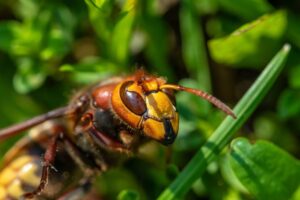Wasps are a common summer pest in Canada. You can often spot them hovering over garbage cans and hanging out around ice cream and hot dog stands. Although people often think wasps are exclusively yellow and black, they can be black and white, and other colours. Here’s what you need to know.
How to tell a wasp from a hornet
Did you know there are over 30,000 species of wasps around the world? The most common types of social wasps in Canada are the yellowjackets and the paper wasps. Bald-faced hornets are also wasps and are just another type of aerial yellowjacket. Canada has one true hornet, the European Hornet, which looks and acts like a wasp.
The major differences between common yellowjackets and hornets are size, colour, and that European hornets can be active at night (unlike most other wasps). Yellowjackets are about one centimetre to two and a half centimetres long. European hornets are larger, about three to five centimetres long. Moreover, yellowjackets have the classic black and yellow rings, the bald-faced “hornets” have black and white rings, and European hornets are black and yellow with red/reddish-brown markings on their heads and bodies.
How to locate and treat an infestation
Do you see a bunch of wasps flying back and forth to a specific place? That’s a telltale sign that there’s probably a nest or food source nearby. You can often tell if you have a yellowjacket or hornet problem by finding the nest.
Despite the size, how you treat the nest depends largely on the location. Here are a few tips for eradicating different types of wasp nests:
- Exposed nest. If you can see the wasp nest hanging from somewhere such as a branch or eavestrough, you can use a foam insecticide or aerosol spray labelled to treat it.
- Ground nest. If you can see an opening in the ground that leads to a nest, but can’t see the nest itself, use a dust or granular insecticide. Once you know all the wasps have been eliminated, you can fill in the entrance.
- Hidden nest. It’s common for wasps to nest in wall voids, attics, and spaces in and under places like stairs. If you can see wasps flying to and from a hidden location, it’s best to contact the Poulin’s Pest Control team. Hidden nests can be very challenging to treat yourself, but a labelled insecticidal dust can be applied into the wasp entry points. Avoid sealing the wasp nest entry points until all the wasps are gone.
As the wasp population exhibits an early and substantial resurgence this year, pest control specialists are observing a noticeable surge in Winnipeg. Given that wasps are less active in the evening due to their impaired night vision, it is strategically advised to carry out treatments during the darker hours, enhancing their effectiveness while minimizing the risk of stings. It’s important to note that, unlike bees, wasps have the capacity to sting repeatedly, which can pose an increased threat, particularly to young children or individuals with allergies.
Professional wasp management solutions
If you’re dealing with a wasp problem in your home or business, Poulin’s Pest Control can help. We carry various products labelled for wasp control such as powders, residual sprays, foams, and traps to rid your space of these flying critters. Our team can help you tackle hard-to-access nests and ensure they don’t return. Contact us for more information and expert advice.

